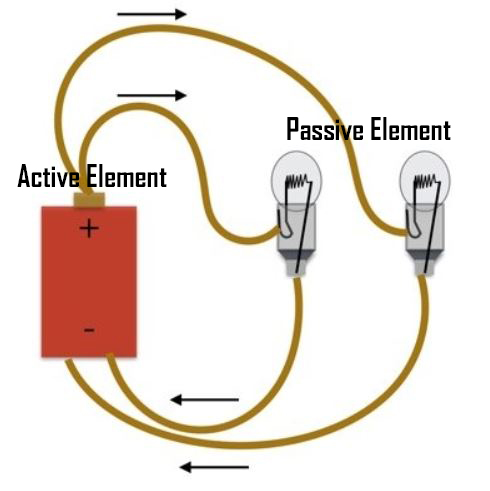Active & Passive Components - What Is The Difference Between The Two?
Active Components and Passive Components
ACTIVE COMPONENTS are made up of Diodes, Integrated Circuits, MOSFETs, JFETs, Optoelectronics, Oscillators and Transistors. PASSIVE COMPONENTS are made up of Capacitors, Inductors/Magnetics, Resistors, Substrates & Interconnects, Energy and High Frequency Components.
For detailed PRODUCT INFORMATION about these ACTIVE and PASSIVE COMPONENTS and the world class manufactures who make them, CLICK HERE.
ACTIVE ELECTRONIC COMPONENTS
|
SEMICONDUCTORS |
TRANSISTORS |
|
|
PASSIVE ELECTRONIC COMPONENTS
|
BASIC COMPONENTS |
ELECTROMECHANICAL COMPONENTS |
|
|
WHAT’S THE DIFFERENCE?
|
Active Components |
Passive Components |
|
Active Device transforms and injects power or energy into a circuit. |
Passive Device utilizes power or energy into a circuit. |
|
Examples: Diode, Transistor, SCR, ICs, DC generator, Current & Voltage sources etc. |
Examples: Resistors, Capacitors, Inductors, Transformer, Motors etc. |
|
Active element produces energy in the form of voltage or current |
Passive element stores energy in the form of voltage or current. |
|
They have function and provide power gain (Amplifier). |
They do not have function provide power gain. |
|
It can control the flow of current. |
It cannot control the flow of the current. |
|
Active components require an external & conditional source to operate in the circuit. |
Passive Components do not require any external source to operate in the circuit. |
|
They have gain more than 1, so they can amplify the signal. |
They have gain less than 1, so they can’t amplify the signal. |
|
They are energy donor. |
They are energy acceptor |
|
They lay in Linear category |
They lay in Non-Linear category. |
The Two Types of Electronic Devices
Electronic elements that make up a circuit are connected together by conductors to form a complete circuit.
Active components
Passive components
Active Components
An active component is an electronic component which supplies energy to a circuit.
Common examples of active components include:
Voltage sources
Current sources
Generators (such as alternators and DC generators)
All different types of transistors (such as bipolar junction transistors, MOSFETS, FETs, and JFET)
Diodes (such as Zener diodes, photodiodes, Schottky diodes, and LEDs)
Voltage Sources
A voltage source is an example of an active component in a circuit. When current leaves from the positive terminal of the voltage source, energy is being supplied to the circuit. As per the definition of an active element, a battery can also be considered as an active element, as it continuously delivers energy to the circuit during discharging.
Current Sources
A current source is also considered an active component. The current supplied to the circuit by an ideal current source is independent of circuit voltage. As a current source is controlling the flow of charge in a circuit, it is classified as an active element.
Transistors
Although not as obvious as a current or voltage source – transistors are also an active circuit component. This is because transistors are able to amplify the power of a signal (see our article on transisors as an amplifier if you want to know exactly how).
Passive Components
A passive component is an electronic component which can only receive energy, which it can either dissipate, absorb or store it in an electric field or a magnetic field. Passive elements do not need any form of electrical power to operate.
As the name ‘passive’ suggests – passive devices do not provide gain or amplification. Passive components cannot amplify, oscillate, or generate an electrical signal.
Common examples of passive components include:
Resistors
Inductors
Capacitors
Transformers
Resistors
A resistor is taken as a passive element since it can not deliver any energy to a circuit. Instead resistors can only receive energy which they can dissipate as heat as long as current flows through it.
Inductors
An inductor is also considered as passive element of circuit, because it can store energy in it as a magnetic field, and can deliver that energy to the circuit, but not in continuous basis. The energy absorbing and delivering capacity of an inductor is limited and transient in nature. That is why an inductor is taken as a passive element of a circuit.
Capacitors
A capacitor is considered as a passive element because it can store energy in it as electricfield. The energy dealing capacity of a capacitor is limited and transient – it is not actually supplying energy, it is storing it for later use.
As such it is not considered an active component since no energy is being supplied or amplified.
Transformers
A transformer is also a passive electronic component. Although this can seem surprising since transformers are often used to raise voltage levels – remember that power is kept constant.
When transformers step up (or step down) voltage, power and energy remain the same on the primary and secondary side. As energy is not actually being amplified – a transformer is classified as a passive element.
Source: Electrical 4U.com



